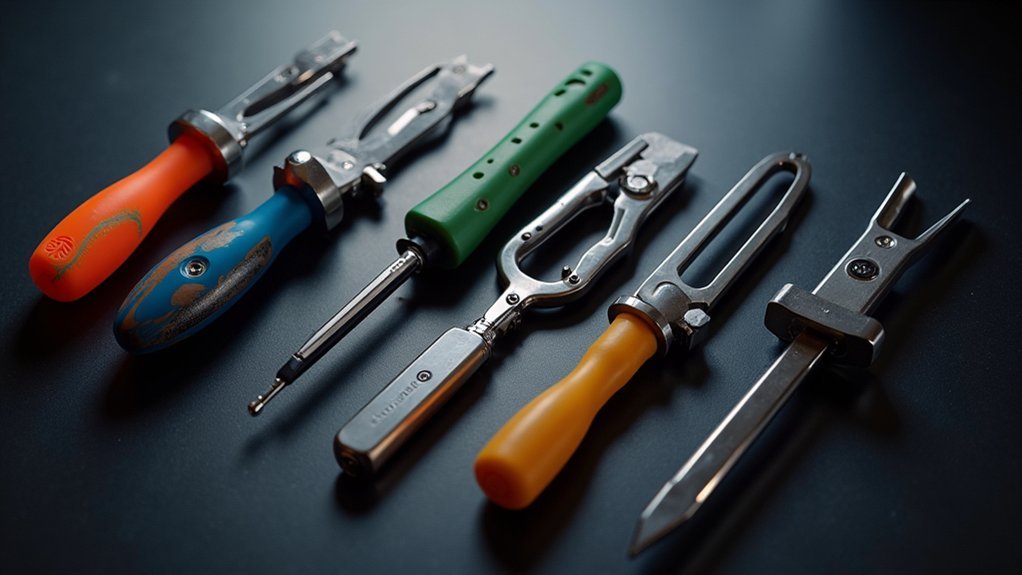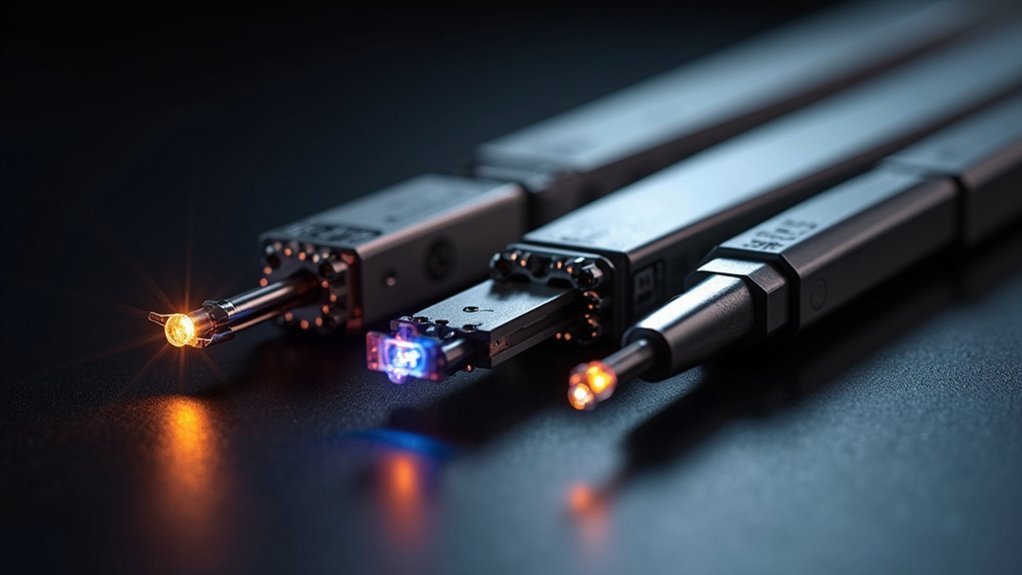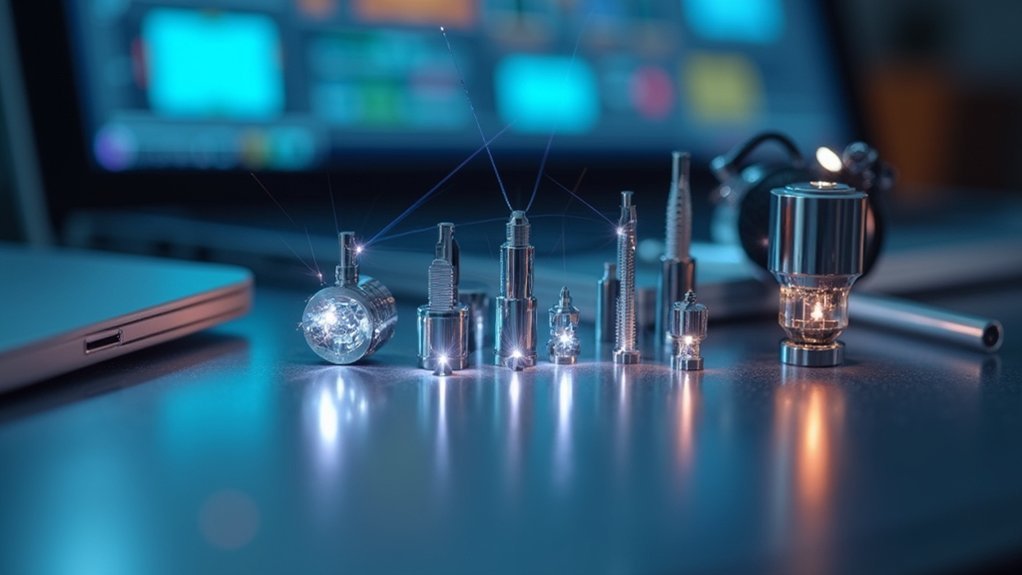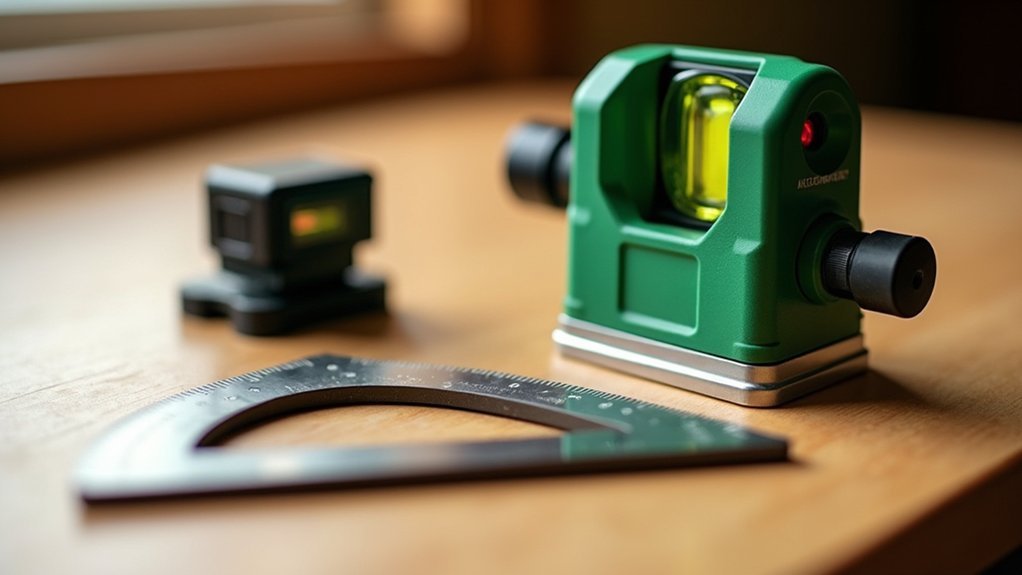The best light alignment tools for microscopes depend on your specific needs. Budget options like the AT-100 work for occasional use, while professionals should consider advanced systems like the AT-400 or EasyLaser E540. Look for adjustable intensity, built-in filters, and LED technology for peak performance. Software-assisted options like TEXA’s IDC6 can reduce alignment time by 50%. Regular maintenance guarantees consistent results and extends equipment lifespan. Discover how proper alignment dramatically improves your image quality.
Understanding Light Alignment Fundamentals for Microscope Photography

When capturing the microscopic world through photography, proper light alignment stands as the cornerstone of exceptional image quality.
You’ll find that even the smallest adjustments to your light source’s angle and distance dramatically affect contrast and brightness in your images.
To achieve consistent results, you’ll need reliable alignment tools that help position your illumination precisely. A light meter becomes invaluable when calibrating intensity across different sample types, ensuring accurate exposure every time.
Precise alignment tools and calibrated light metering transform ordinary specimens into extraordinary microscopic revelations.
Don’t overlook the importance of diffusers and filters—these simple tools can eliminate glare and unwanted shadows that might otherwise obscure critical details.
Make regular alignment checks part of your workflow. This practice prevents artifacts and inconsistencies that could compromise your specimen’s representation, ultimately delivering the clarity and detail your microscope photography deserves.
Key Features to Look for in Microscope Lighting Alignment Tools
Selecting the right lighting alignment tools for your microscope requires attention to specific features that directly impact image quality and workflow efficiency. When evaluating an alignment system, prioritize tools offering adjustable light intensity, which enhances visibility across diverse specimen types.
You’ll want built-in filters that modify light wavelengths, allowing better differentiation of specimens under observation. Choose tools compatible with multiple microscope models to guarantee versatility across laboratory settings.
Don’t overlook ergonomic design—it minimizes fatigue during extended use while enabling precise adjustments.
LED technology should be at the top of your checklist, as these lights offer significant advantages: longer lifespan, reduced heat emission, and greater energy efficiency compared to traditional light sources.
These features collectively contribute to more accurate specimen analysis and improved microscopy results.
Budget-Friendly vs. Professional-Grade Alignment Solutions

When selecting light alignment tools, you’ll need to weigh your budget against required precision capabilities, as budget-friendly options like the AT-100 offer sufficient 2-meter range for occasional tasks while professional-grade solutions like the AT-400 provide 20-meter range and advanced monitoring for complex applications.
You can opt for cost-effective alternatives such as the EasyLaser E540, which balances affordability below $10k with essential wireless features suitable for many workshop environments.
If you’re handling both alignment and vibration measurement needs, consider investing in versatile equipment like the CSI 2130 that combines multiple functions into a single tool.
Cost vs. Precision Tradeoffs
Although budget-friendly alignment tools offer an accessible entry point for occasional users, they represent just one end of a spectrum that extends to sophisticated professional-grade solutions with considerable price differences.
When considering cost vs. precision tradeoffs, you’ll find basic models like the AT-100 with a 2-meter range priced as low as $17.45, while professional options like the EasyLaser E420 can reach $5,300.
Your decision should factor in long-term benefits beyond initial cost.
Professional-grade systems like the eLight save up to 50% on alignment time and offer advanced features including integrated diagnostics and extensive reporting.
While the AT-400’s 20-meter range and live monitoring capabilities require greater investment, they deliver enhanced accuracy that can considerably reduce labor costs and training time.
DIY vs. Workshop Solutions
The difference between DIY and workshop alignment solutions extends far beyond their price tags, touching every aspect of the alignment process itself.
Basic laser levels or the AT-100 with its 2-meter range may serve your occasional alignment needs, but they lack the precision required for professional work.
Workshop environments benefit tremendously from professional tools like the eLight system, which cuts alignment time by up to 50% through electronic diagnostics and autodiagnostics features.
For busy shops, the $5,300 EasyLaser E420 with Bluetooth wireless heads offers significant efficiency gains over budget options.
While DIY alignment tools might satisfy home mechanics, professional-grade equipment guarantees compliance with industry standards and accommodates modern vehicle technologies.
The eLight ONED’s 7-inch touchscreen enables standalone operation—a feature worth the investment for workshops prioritizing accuracy and reliability.
Fiber Optic Illuminators and Their Alignment Mechanisms
Precision stands at the core of fiber optic illuminator technology, where bundles of glass or plastic fibers work together to transmit light with remarkable accuracy.
You’ll find these devices essential when your laser alignment tool requires perfect positioning for maximum efficiency.
The adjustable focus mechanisms let you optimize light distribution and intensity for specific tasks.
Remember, even slight misalignment can dramatically reduce transmission efficiency, compromising your entire system’s performance.
Modern fiber optic illuminators feature modular components, making maintenance straightforward when individual fibers or connectors need replacement.
For more demanding applications, advanced models include electronic diagnostics that provide real-time alignment feedback.
These features guarantee you’ll achieve consistent light delivery whether you’re working with medical instruments or industrial machinery that requires precise illumination.
LED Lighting Systems and Precision Positioning Controls

Modern LED lighting systems demand exact alignment tools to achieve their full potential while preventing dangerous conditions on the road.
When you’re working with LED headlights, you’ll need to make certain they’re positioned precisely to manufacturer specifications for ideal visibility and safety.
Systems like eLight offer integrated diagnostics that can:
- Save up to 50% of alignment time through built-in camera technology
- Provide detailed reporting to verify compliance with safety standards
- Guarantee proper beam patterns that won’t blind oncoming drivers
The alignment process typically requires careful distance measurements as outlined in your vehicle’s manual.
Regular checks using reliable tools like eLight ONE and ONED are imperative—misaligned LEDs greatly reduce visibility, creating hazardous driving conditions.
Proper positioning controls with diagnostic capabilities are your best bet for maintaining safe, effective LED lighting.
Ring Lights vs. Spot Illumination: Alignment Considerations
When selecting the right illumination for alignment tasks, you’ll need to carefully weigh the benefits of ring lights against spot illumination systems.
Ring lights provide uniform light distribution around objects, minimizing shadows that could interfere with precision measurements. This makes them ideal for larger surface alignments where consistent illumination is essential.
Spot illumination, however, excels at focusing light on specific areas, making it perfect for detailed work in confined spaces. You’ll find this approach beneficial when identifying misalignments in tight components, though be cautious of potential shadow creation.
Consider your object’s size and shape when choosing between these options.
For maximum accuracy in complex alignment tasks, you might benefit from combining both lighting techniques, leveraging the thorough visibility they provide together.
Software-Assisted Light Alignment Technologies

While traditional illumination systems provide foundational support for alignment tasks, software-assisted light alignment technologies represent a significant advancement in precision capabilities.
Software-assisted light alignment technologies elevate precision beyond traditional systems, revolutionizing modern alignment capabilities.
TEXA’s IDC6 enhances tools like eLight through electronic system dialogue and integrated autodiagnostics, drastically reducing your alignment time by up to 50%.
- The eLight ONED version features a 7-inch swiveling touchscreen that you can operate independently or connect with existing diagnostic tools.
- Advanced algorithms and built-in cameras guarantee precise alignment for all modern headlight technologies including halogen, xenon, LED, and laser.
- Detailed reports are automatically generated for your garage worksheets, helping you stay compliant with upcoming PTI legislation.
You’ll appreciate how these software-assisted light alignment technologies streamline your workflow while improving accuracy—essential for today’s sophisticated vehicle lighting systems.
Real-World Performance Testing of Top Alignment Tools
Although theoretical specifications provide valuable information, real-world performance testing reveals how alignment tools actually perform under workshop conditions.
When evaluating systems like the CSI 2130 and EasyLaser E540, you’ll find their practical advantages become immediately apparent.
The CSI 2130’s wireless laser heads eliminate tangled wires, greatly improving your operational efficiency during alignment tasks.
Meanwhile, the EasyLaser E540 delivers premium capabilities at under $10,000, making it cost-effective without sacrificing performance.
Before conducting real-world performance testing, verify proper calibration and complete pre-alignment checks for reliable results.
Evaluate tools using both clock and continuous sweep methods to account for thermal growth and coupling train alignment.
These evaluation criteria give you concrete metrics to compare how these multifunctional systems will perform in your specific industrial environment.
Maintenance and Calibration of Microscope Lighting Equipment

Since proper illumination forms the backbone of accurate microscopy, maintaining and calibrating your microscope lighting equipment should be a top priority in your lab routine.
Regular cleaning of light sources and lenses guarantees peak brightness and prevents image distortion that could compromise your research.
Neglecting optical component maintenance directly impacts image quality and undermines experimental integrity.
Remember that the right tool is the one that matches your specific microscopy needs:
- Use a light meter to quantify intensity across your field of view, assuring uniform illumination
- Adjust illumination intensity based on your specimen—over-illumination creates glare and obscures detail
- Store equipment away from dust and temperature extremes to extend component lifespan
Periodic calibration confirms your light’s intensity and color temperature meet required specifications.
This routine maintenance not only improves visual accuracy but also protects your investment in precision equipment.
Frequently Asked Questions
How Accurate Is a Laser Alignment Tool?
Laser alignment tools are highly accurate, offering precision within ±0.002 inches. You’ll get real-time feedback and can measure thermal growth. They’re perfect for demanding industrial applications where you can’t afford alignment errors.
What Tool Do You Need to Adjust Headlights?
You’ll need a headlight alignment tool like the eLight system, basic hand tools (screwdrivers and sockets), and a flat surface with wall measurements. Electronic diagnostics provide the most accurate adjustments for modern headlights.
What Is the Headlight Alignment Tool Called?
The headlight alignment tool is called a headlight tester or headlight alignment system. You’ll find specific models like eLight that use cameras and diagnostics to help you properly aim your vehicle’s headlights for safety.
What Tool Is Used for Alignment?
For alignment, you’ll use various laser devices like the AT-100 for small machines or the AT-400 for industrial applications. You can also choose multifunctional tools like the CSI 2130 or EasyLaser series for combined alignment capabilities.
In Summary
You’ll find that proper light alignment transforms your microscope photography regardless of budget. Choose tools matching your specific needs—whether fiber optics for precision or LED systems for consistency. Don’t overlook regular calibration, as it’s essential for maintaining alignment accuracy. Remember, the best tool isn’t always the most expensive one, but rather the one that delivers reliable illumination for your particular specimens.





Leave a Reply